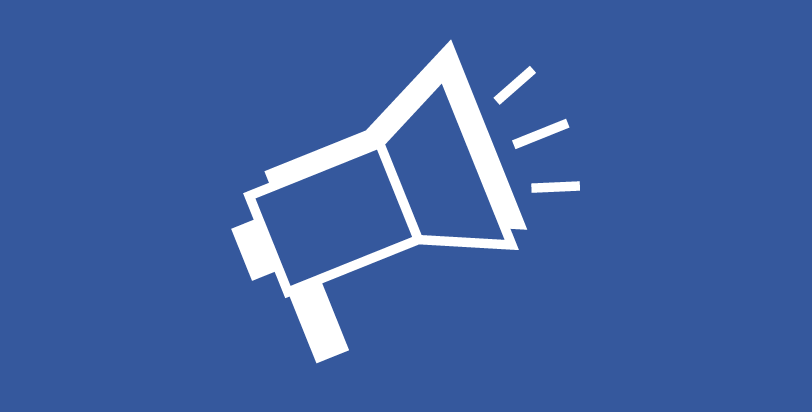What parties pent the most on political ads on Facebook, what region is most interesting for the OPFL, what the age group of women most attractive for the Shariy Party.
The official launch of election campaign in Ukraine was on September, 5. However, most active political parties that counted upon the participation in local elections had started their advertising in social media long before. Even though Facebook obliges to indicate the funding sources for political ads, some political forces cheated and campaigned also from the sources other than their party pages. For example, on August, 19, Facebook started showing the ads of the “For the Future” party paid by the Gofit gym. The “Ukrainian Strategy of Groysman” were using the page of the half-dead outlet visti.live to share their ads, even though the page hardly publishes any news once in a month (also mostly about Groysman).
OPORA analyzed the political ads in the Ukrainian segment of Facebook in June to August, 2020, and identified over 50 parties that spent the total of USD 281,000 (ab. UAH 8 mln) for 8,253 ads.
Next follows the list of ten parties that spent on Facebook ads in the summer over 4 thousand dollars:
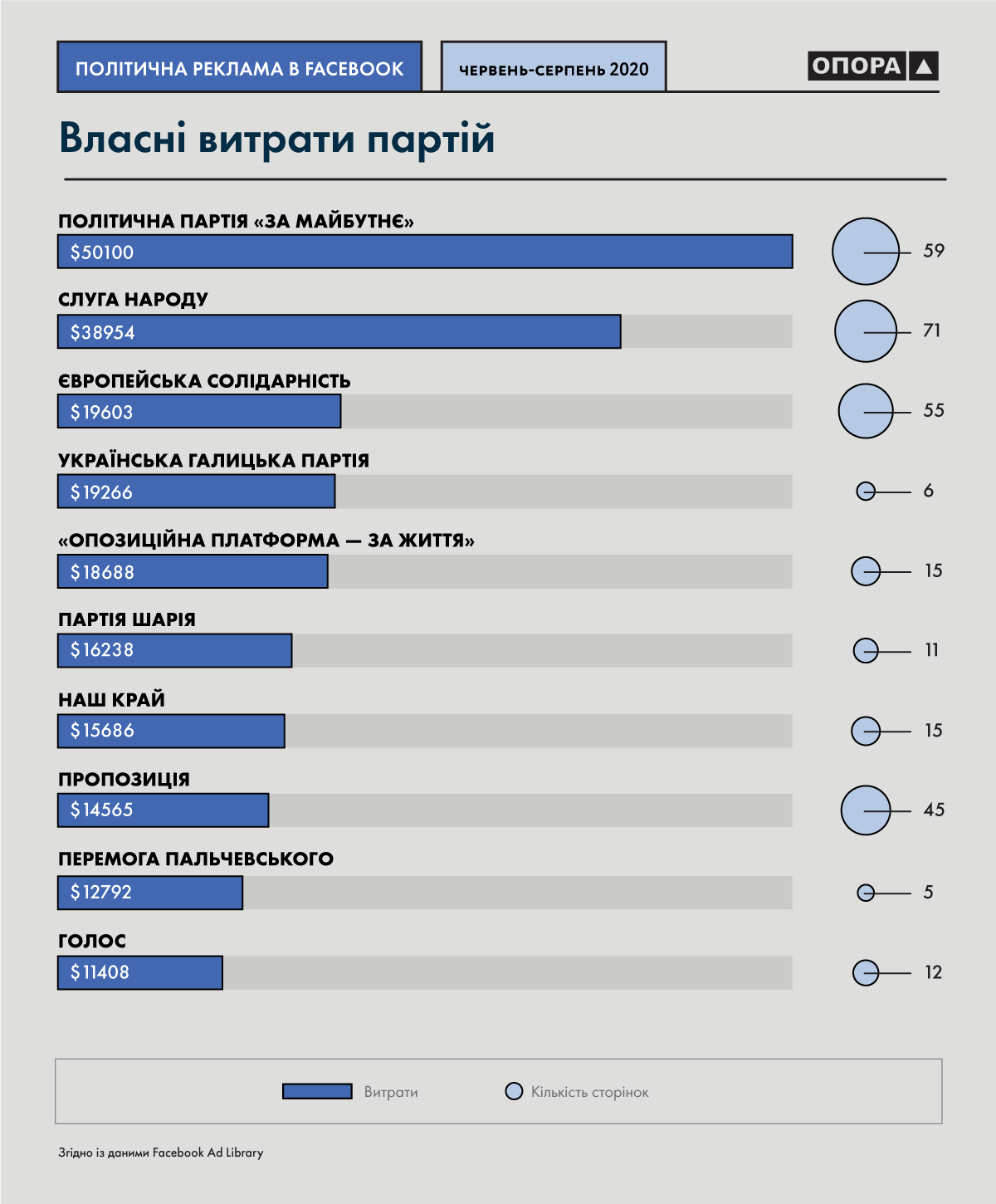
“For the Future” party shows the most impressive results. They have started their advertising rather recently — the first post was published on July, 13, but after August, 6, the ads have proliferated. The advertising posts were shared from the 59 pages — from the party central page and a series of regional pages (Запоріжжя ЗА Майбутнє, [lit. – Zaporizhzhia FOR the Future], Радомишль ЗА Майбутнє [lit. – Radomyshl FOR the Future], a.o.). They posted 1,068 ads, and spent the total of over USD 50,000. Most ads covered the party’s position on various aspects, and introduced the team members running for elections in certain regions. Some posts encouraged to like their party page. Moreover, the posts also covered the party convention on August, 27.
Despite the fact that the “For the Future” present themselves as the national party, and has separate Facebook pages for all Oblasts, the party is more active in northern and western regions. 8% of posts account for Lviv region, almost 6% fall onto Kyiv region, and 5.5% - target Ivano-Frankivsk.
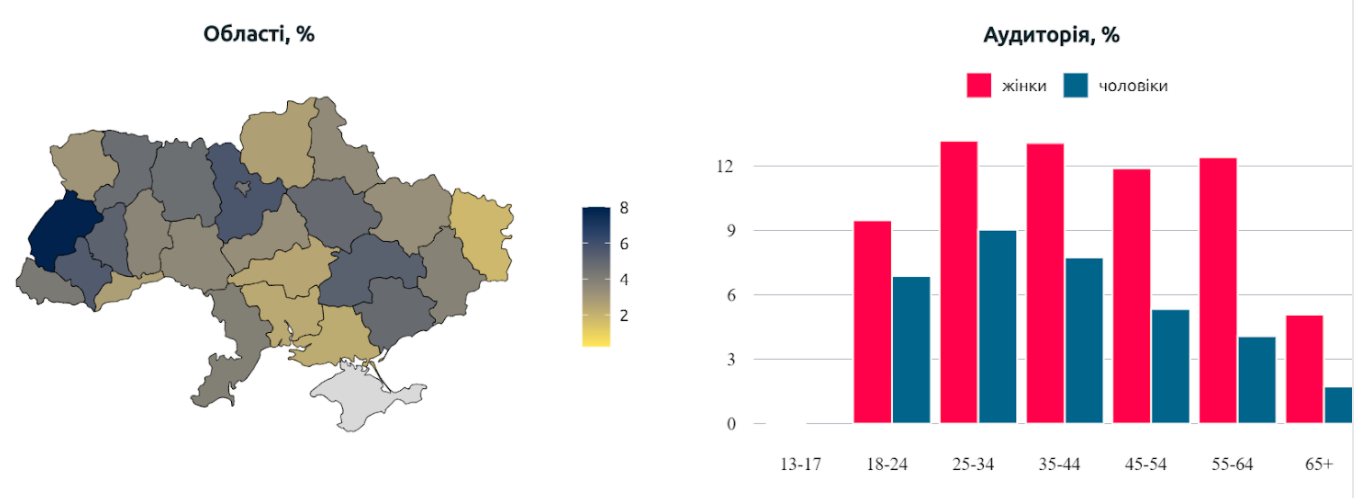
The biggest number of party pages to share political ads was used by the “Servant of the People” party. In the summer, the advertisements were shared by 71 pages. In the run-up to local elections, the social media saw the growth of pages of the “servant of the People.” The local groups were created who also shared ads, for example, “Слуга Народу — Вараський район” [lit. – “Servant of the People – Varash District”]. “Servant of the People” ordered more ads than the “For the Future” — 1,232 ads, but they spent less — almost USD 39,000. In June and July, the pages of the “Servant of the People” published only about three hundred posts, but there were over 900 in August.
The posts were telling about the parliamentary work of the “ Servant of the People” (raising salaries to health care professionals, introducing a paternity leave, etc.). The local pages were often describing the so called “development strategies” suggested by the “Servant of the People” for each region, and introduced candidates for local heads. They often advertised the party and encouraged to join:
:
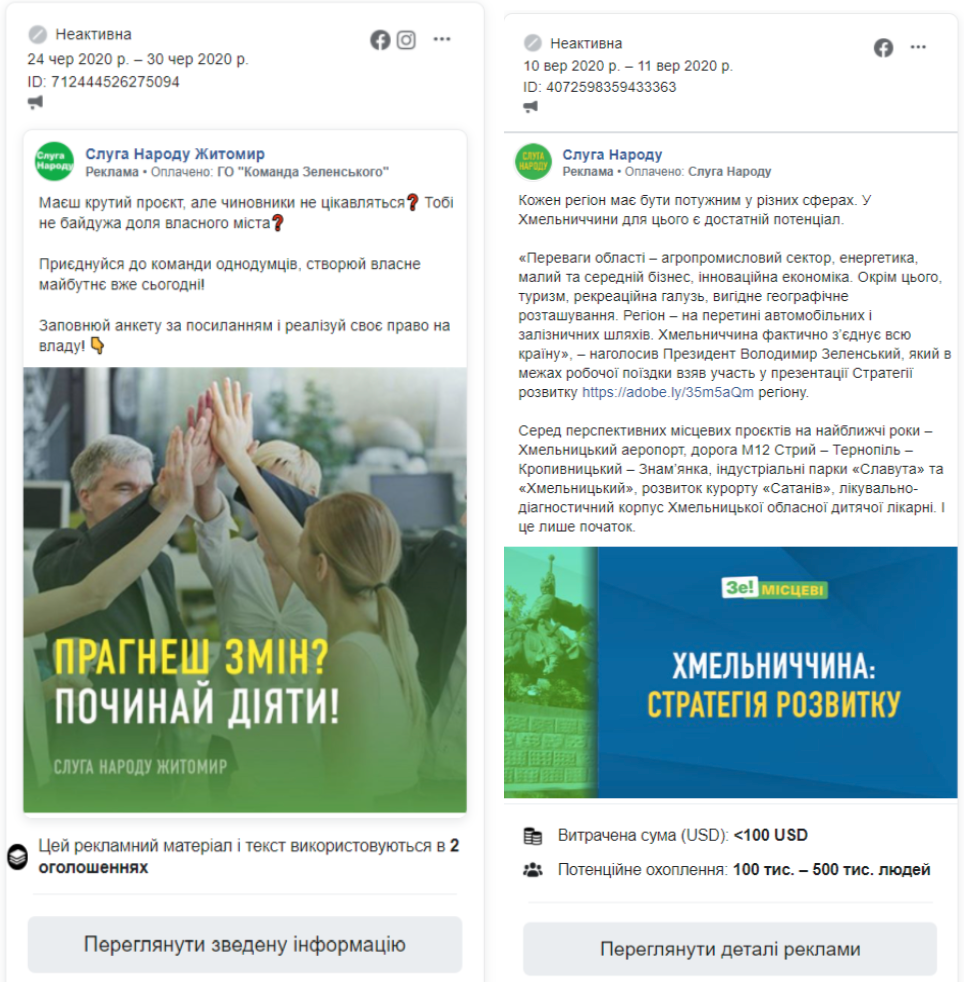
The biggest number of ads from the “Servant” targeted Vinnytsia Oblast (over 13%), Dnipropetrovsk Oblast (almost 8%), and Mykolayiv Oblast (over 6%).

In terms of funds spent for the political ads, next follows the “European Solidarity” — USD 19,600 for 327 ads. The “ES” have ordered political ads during the entire summer, even though they got much more active in the end of August. Most of the 55 pages posting ads of the “ES” covered the party’s position on the political processes and the performance of MPs from the party. Local pages, such as the “Європейська Солідарність Обухівщини” [lit. – European Solidarity of Obukhiv region] introduced local candidates to voters, and invited to join the party. They also promoted posts about lectures, festivals, and even giveaways organized by the party.
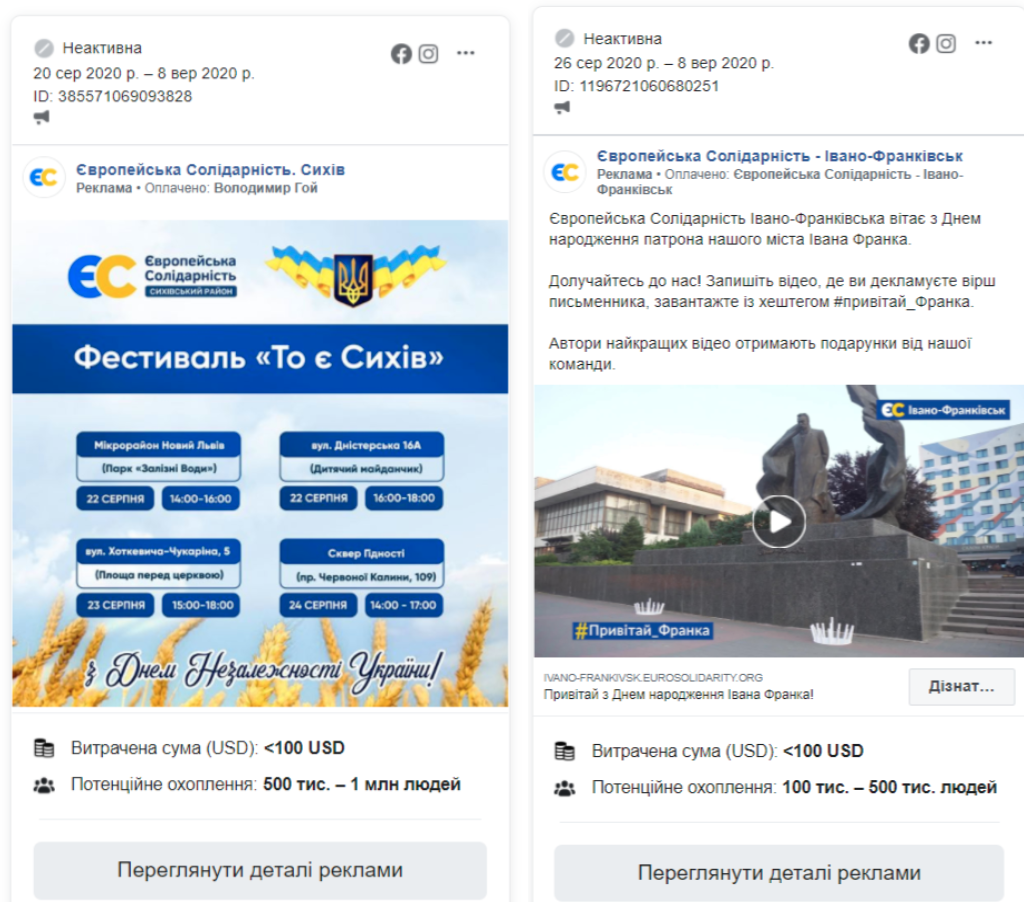
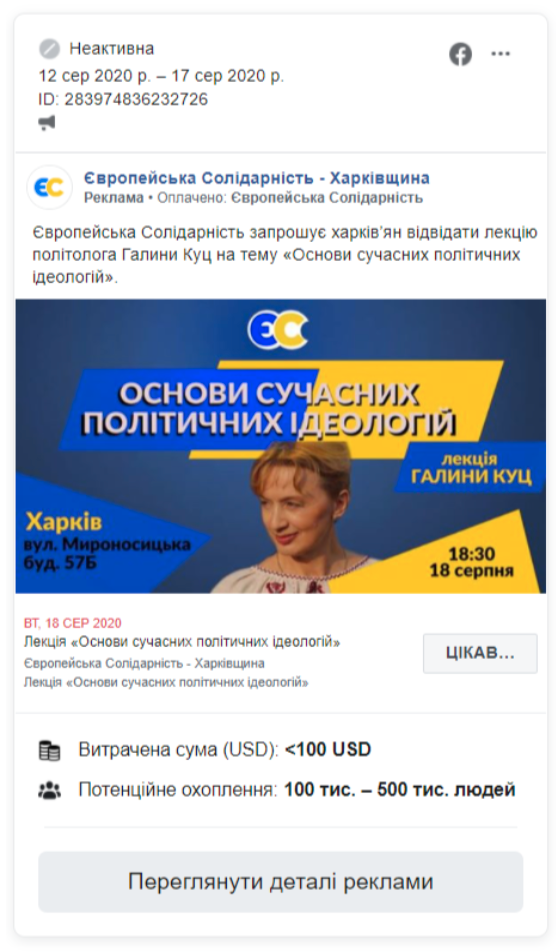
Sometimes, the party pages showed ads inviting to engage in elections in any role:
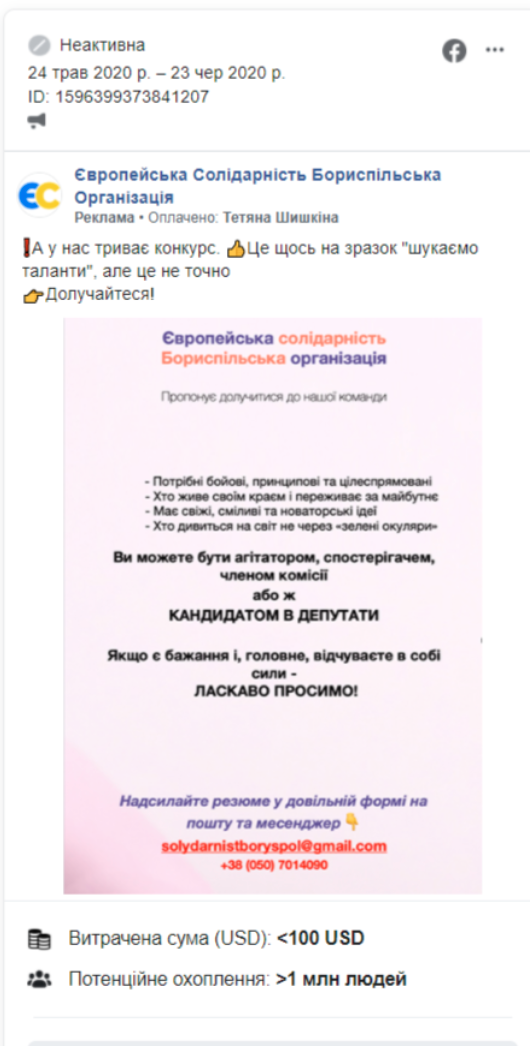
The posts mostly targeted central and western Ukraine. Over 28% of posts targeted Kyiv, almost 10% aimed at Kyiv region, over 8% targeted Lviv region. The large share of Kyiv ads can be explained by the high advertising activity of the page Європейська Солідарність — Київ [.lit. – European Solidarity – Kyiv]: in three months, it spent over USD 6,500.
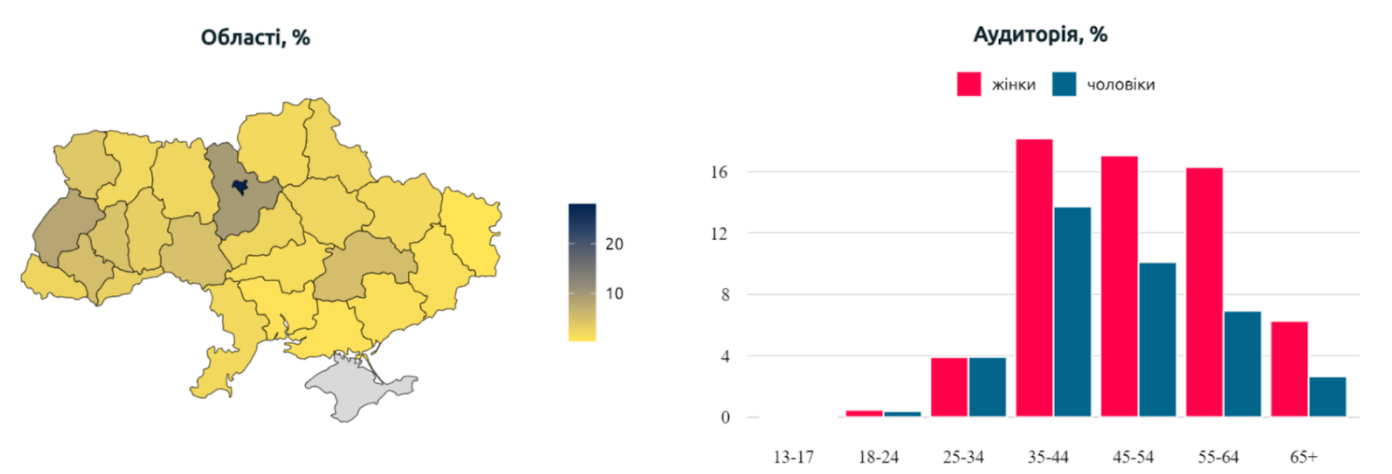
Ukrainian Galician Party spent for advertising over USD 19,000 but order the biggest number of posts. The party’s six pages published 1,330 posts during the summer. Most ads of the UGP were posted in June and July. For the most part, the UGP’s ads were about the posts from local activists, invitations to join the party ranks, introduction of candidates for local heads, and stories about the party’s ideology.
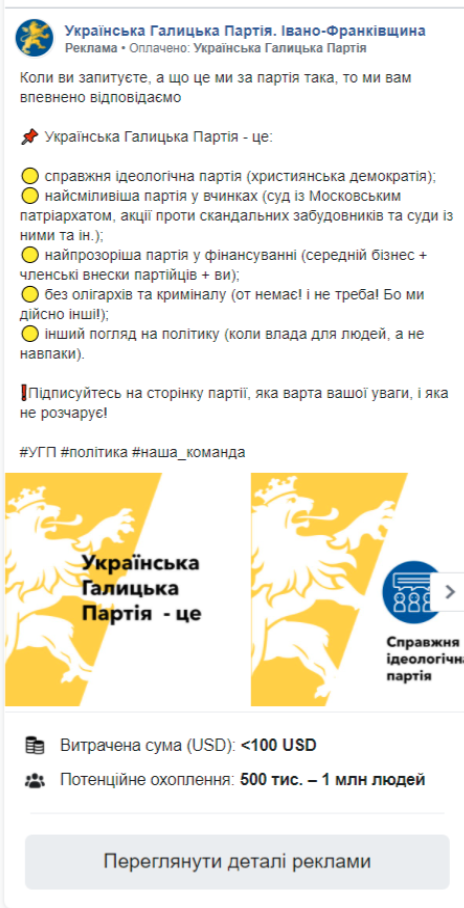
Many ads mentioned local challenges that the UGP promised to address:
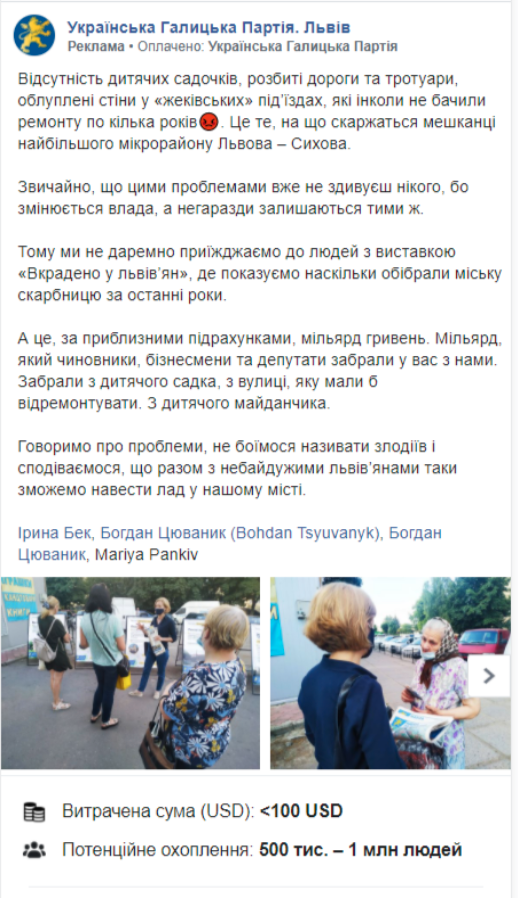
The ads equally targeted the western regions: almost 55% focused on Lviv region, 23% targeted Ivano-Frankivsk area, 20% aimed at Ternopil Oblast, 0.5% targeted Khmelnytskyi region. In other Ukraine’s oblasts, the share of views for the UGP’s ads was poor, the posts seem to be targeting the four western regions.

The 15 pages of the “Opposition Platform — For Life” published 890 posts, having spent the total of USD 18,700. The OPFL shared their advertisements over the entire summer, and were more active than ever in June. Almost all posts were promoting local politicians. Also, there were some posts inviting to follow the OPFL in the social media, and announced about the events organized by the party. The party often wrote about local challenges they promised to tackle.
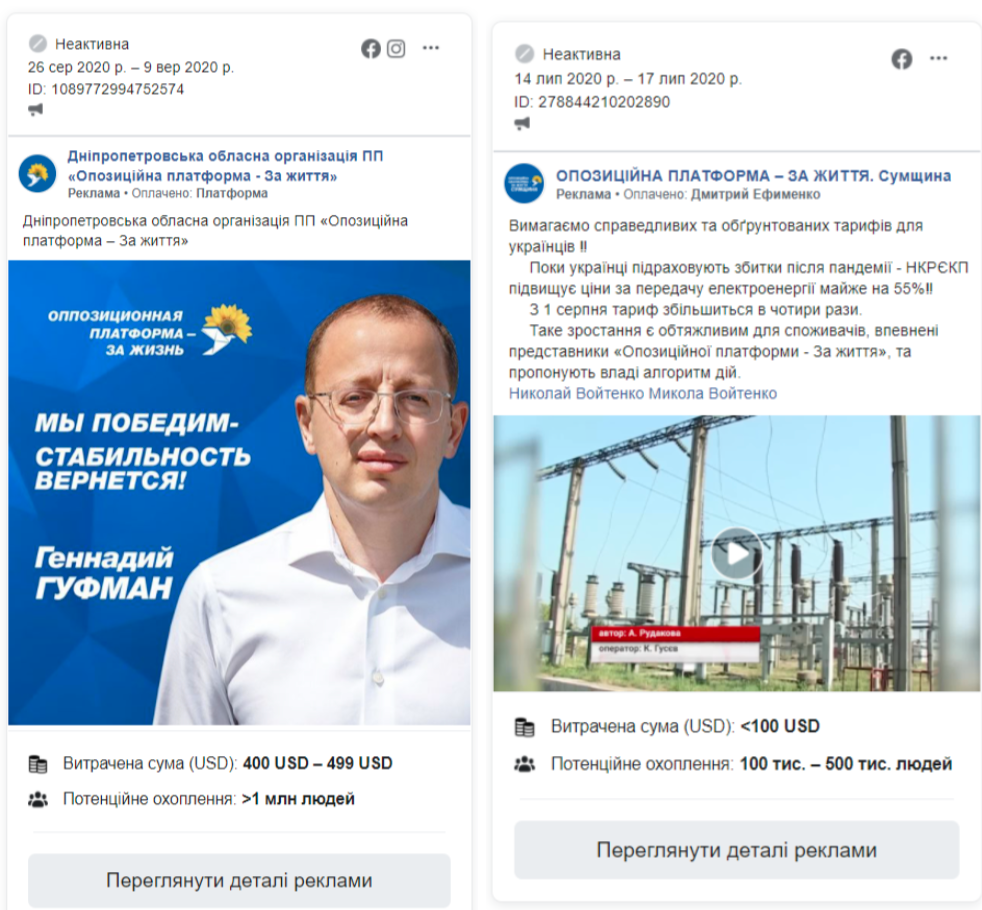
The OPFL targeted eastern regions. In particular, over 90% of advertisements were aiming at Dnipropetrovsk Oblast, 5.5% — at Sumy region. In other regions, the OPFL ads were hardly ever viewed.
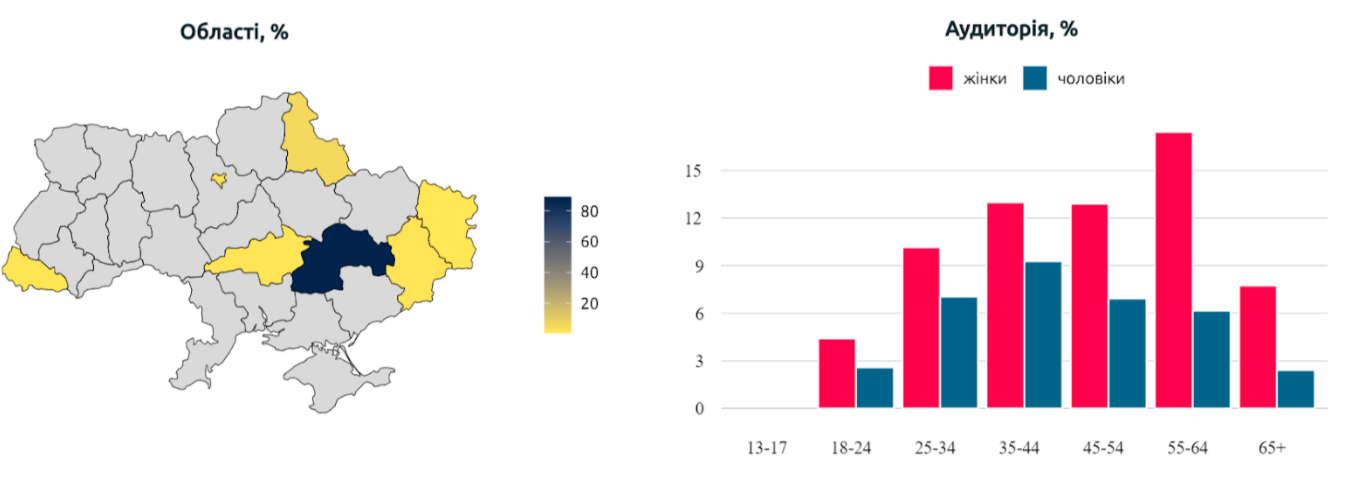
The Shariy Party was actively advertising themselves on six pages throughout the entire summer. In June to August they spent over USD 16,000 for 293 ads. Most of them were the videos with the party leader, a blogger and a politicians Anatoliy Shariy. There were also some posts negative about the authorities in certain regions, and invitations to follow the party pages.

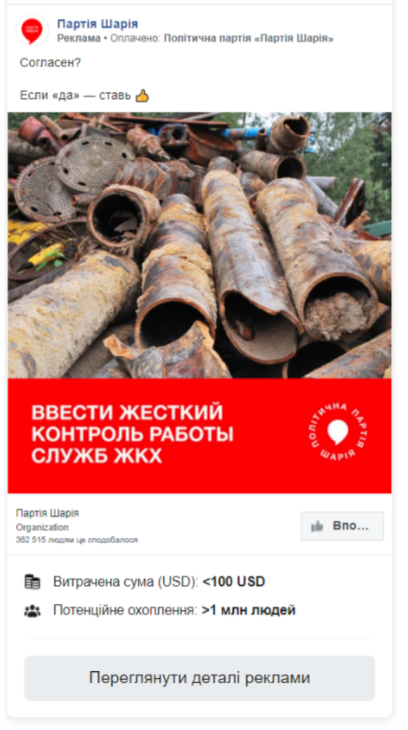
The “Shariy Party” targeted all the regions. The largest share (almost 15%) went for Dnipropetrovsk Oblast. 7% targeted Zaporizhzhia region, almost 5% targeted Transcarpathia, over 5% fell onto Odesa Oblast. It is notable that almost 40% of ad views for the “Shariy Party” was provided by women aged 45 to 64.
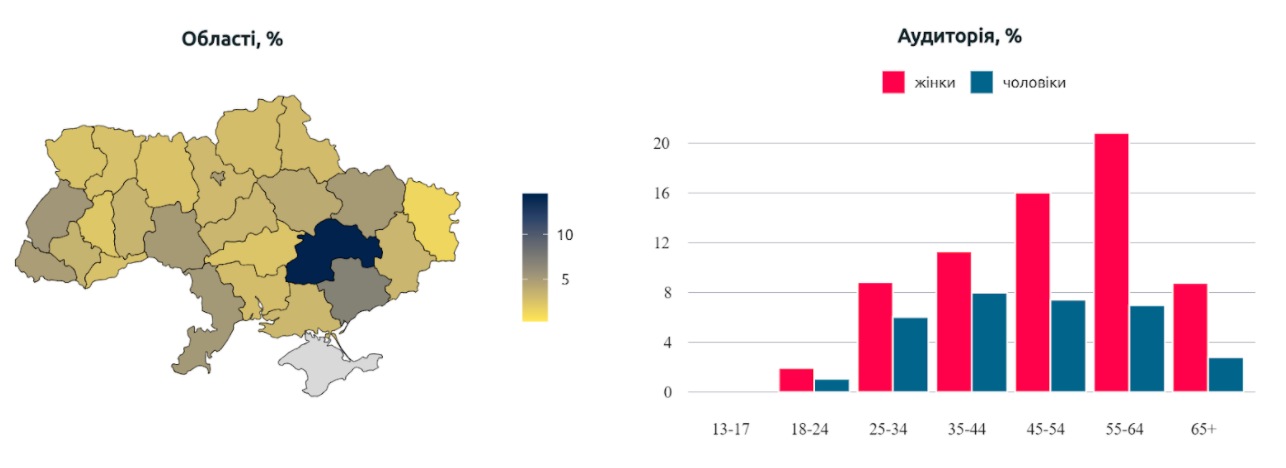
The “Nash Kray” party was actively advertising itself in the social media in the beginning of summer. Later, though, they got more active again in August. In three months, the 15 party pages published 240 posts, for the total amount of USD 15,700. A large part of the posts were about the party’s agenda, or invited to join. Many posts covered the party convention on August, 1, and promoted the party newspaper.
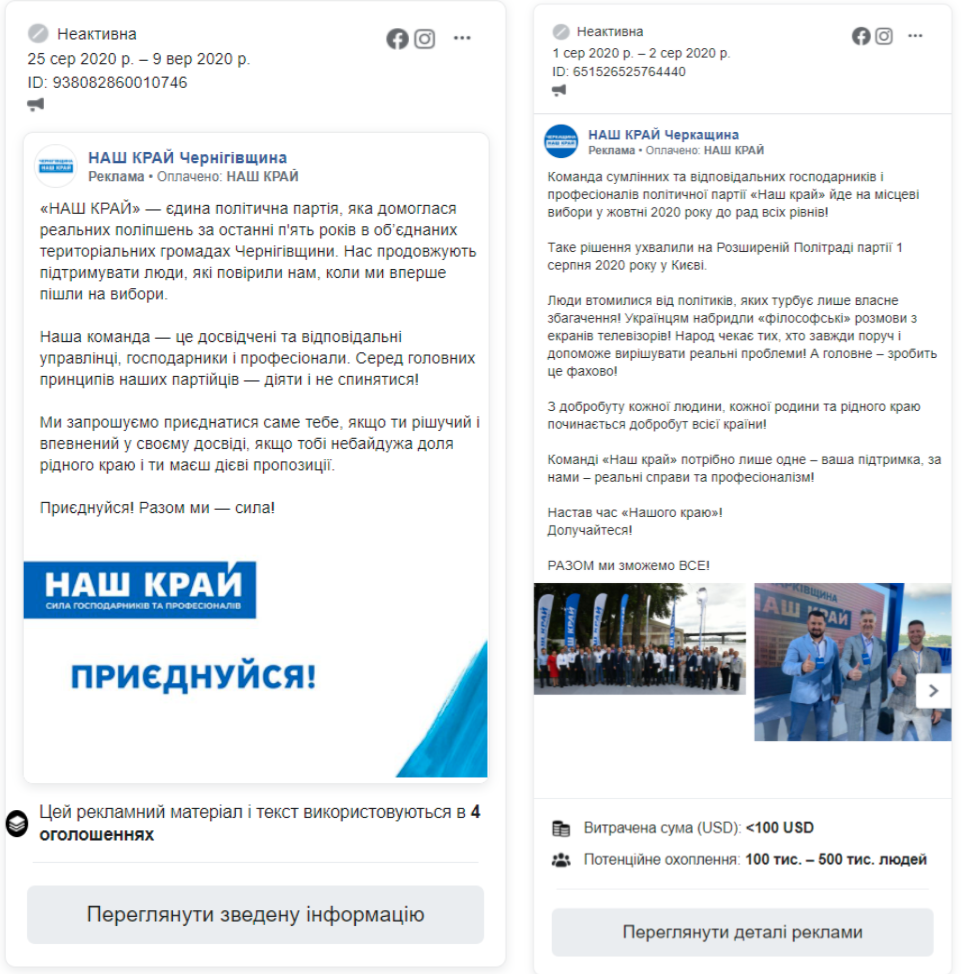
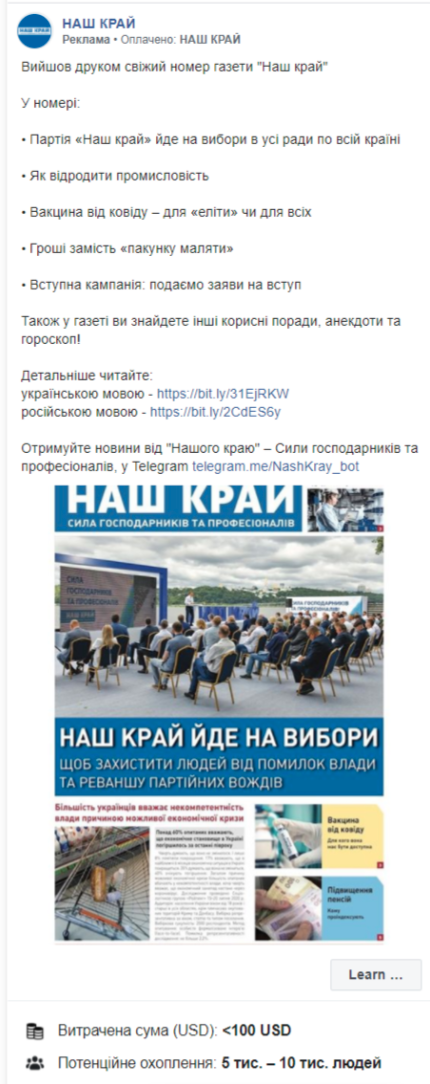
The highest number of ads of the “Nash Kray” targeted Cherkasy Oblast (9.5%), Dnipropetrovsk Oblast (10%), and Vinnytsia Oblast (almost 6%).
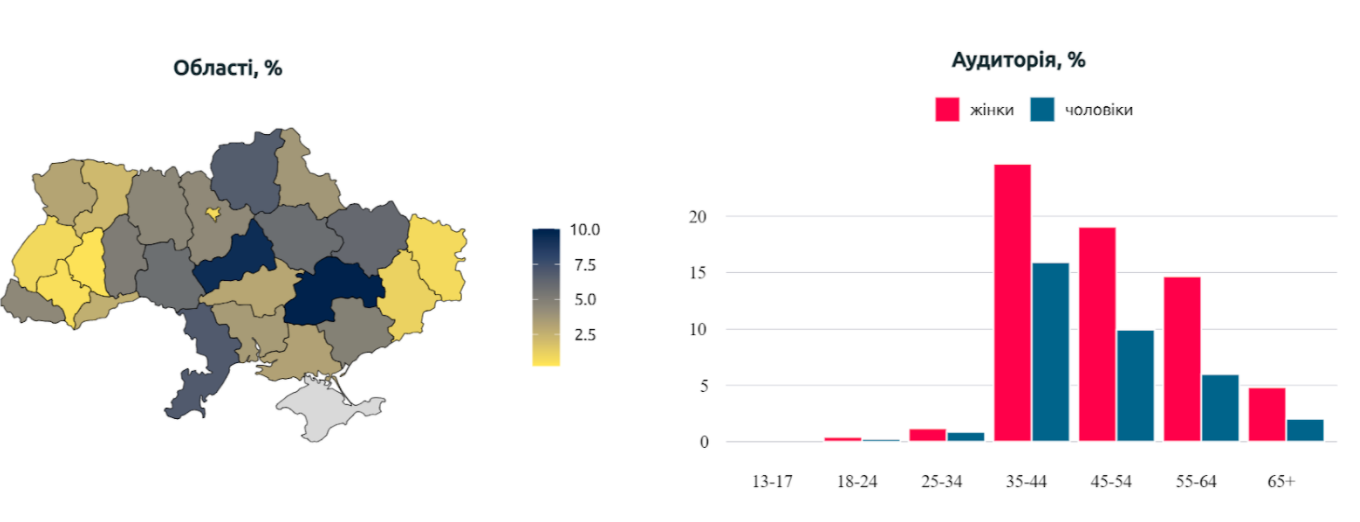
The “Proposition” party published most of their ads after July, 22. From June to August, the 5 pages of the party posted 338 ads, worth USD 14,500. Most ads invited to support the party and follow its pages, introduced local politicians running from the “Proposition,” and greeted with the national or professional holidays. The posts also had some survey results:
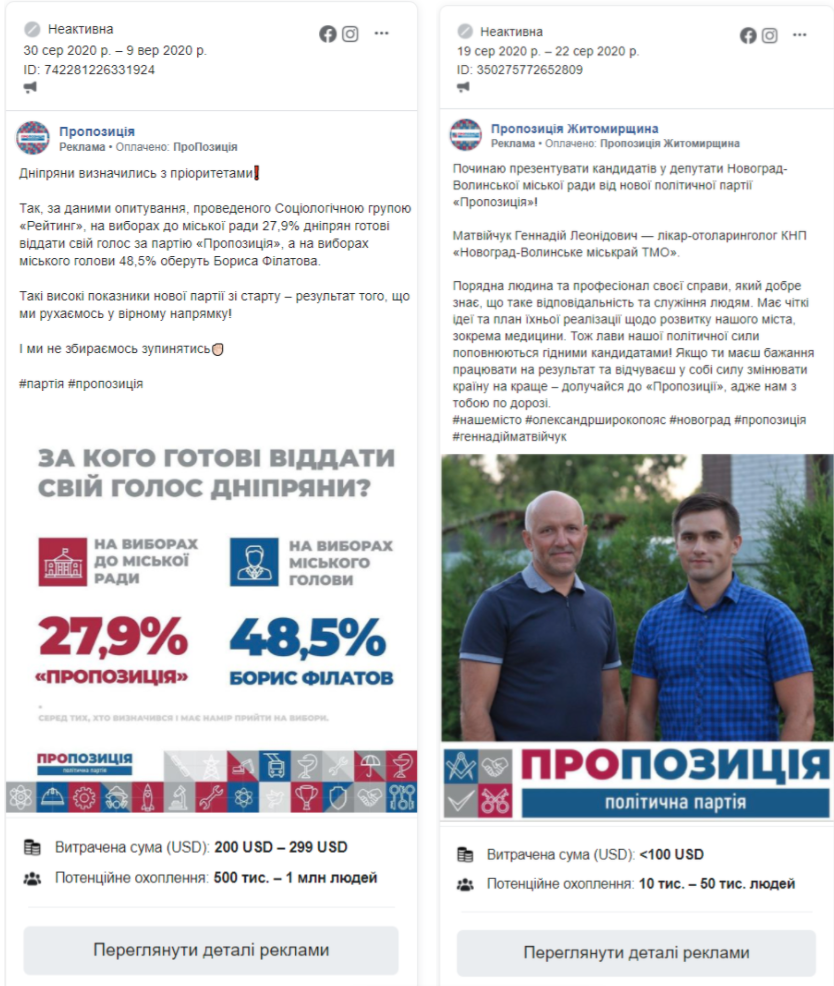
The “Proposition” ads equally targeted the whole of the country – 2 to 4 % per Oblast. However, there were two distinct Oblasts: Dnipropetrovsk faced almost 11% of posts, and over 7% of posts targeted Lviv Oblast.
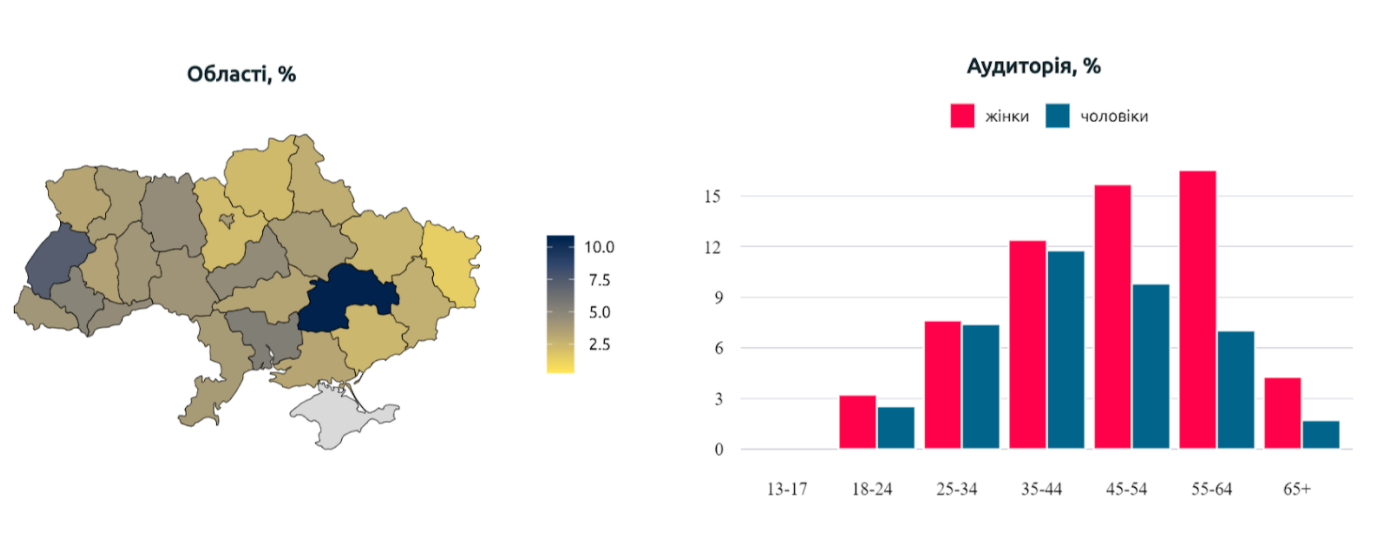
The “Palchevskyi Victory” started their advertising in the end of July, and the peak of activity was in the twentieth of August. The five party pages posted 84 ads, and paid USD 12,800 for them. They were mostly invitations to support the party, to notify local party centers about the issues in local communities that the “Palchevskyi Victory” promised to solve, and posts about the party leader – a businessman and a TV presenter Andriy Palchevskyi.
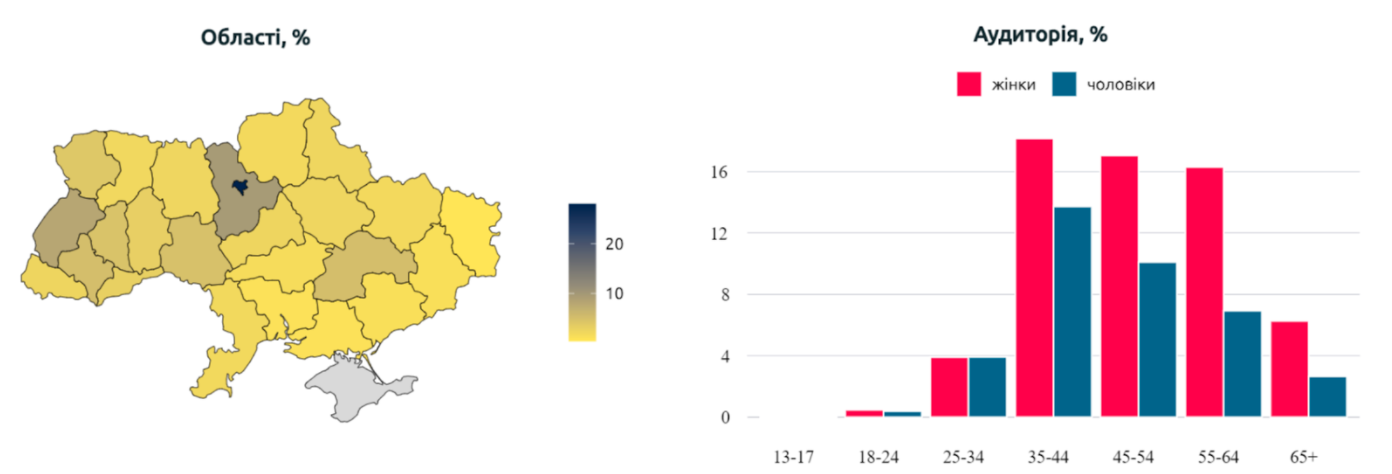
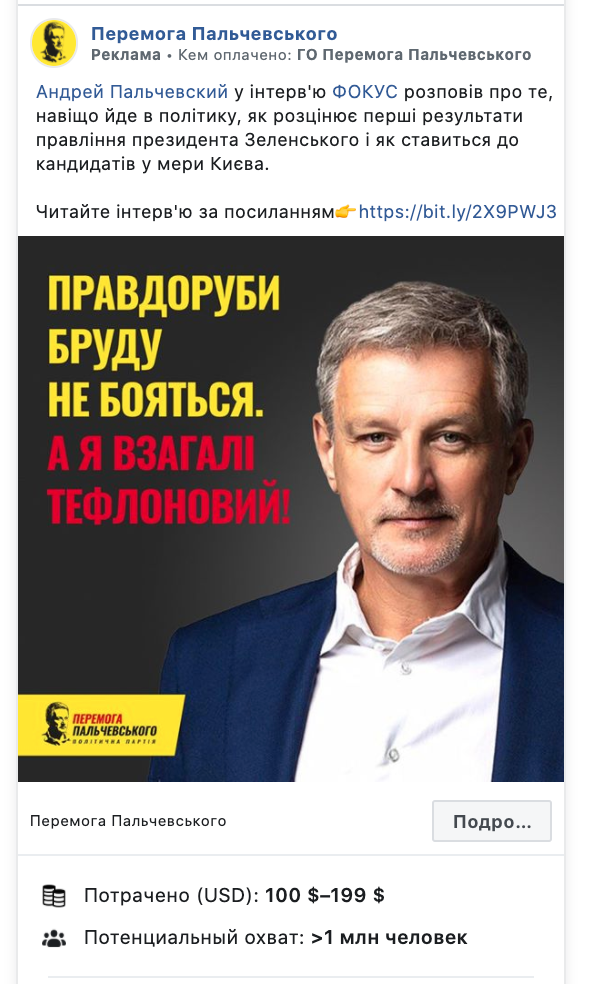
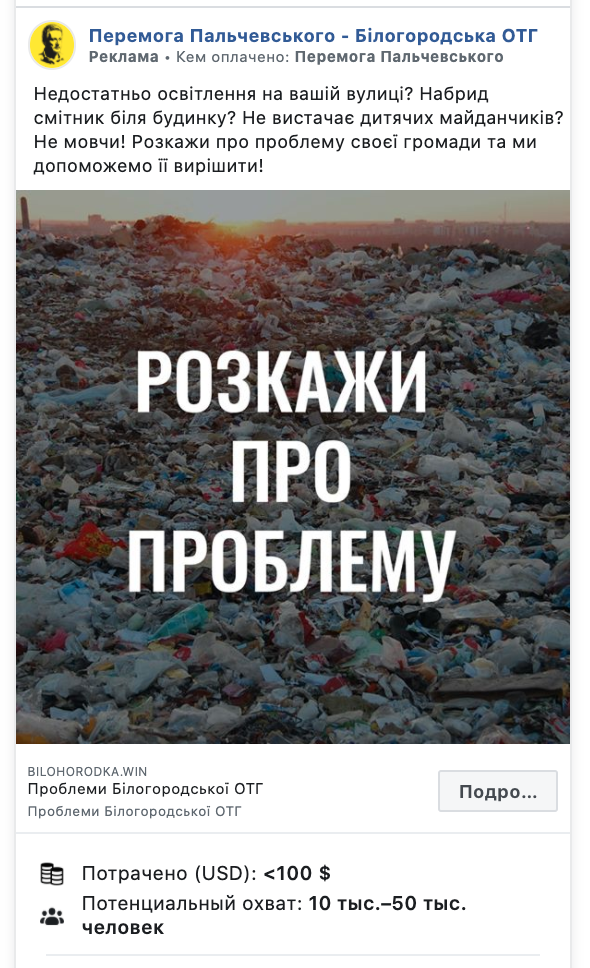
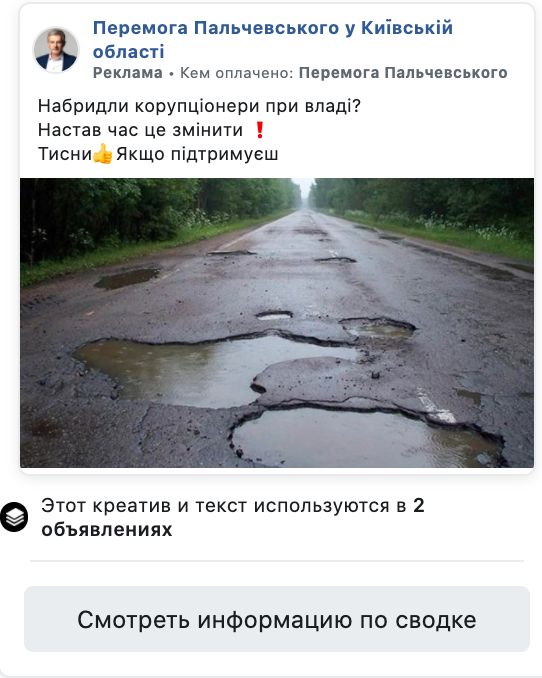
As to the “Holos,” in June to August they posted 154 advertising posts from the 12 pages. They spent USD 11,400 for that. The peak of the party’s advertising activities was in August. Most ads targeted Lviv Oblast (over 22%) and Ivano-Frankivsk region (over 13%), while other Oblasts shared the equal distribution among themselves.
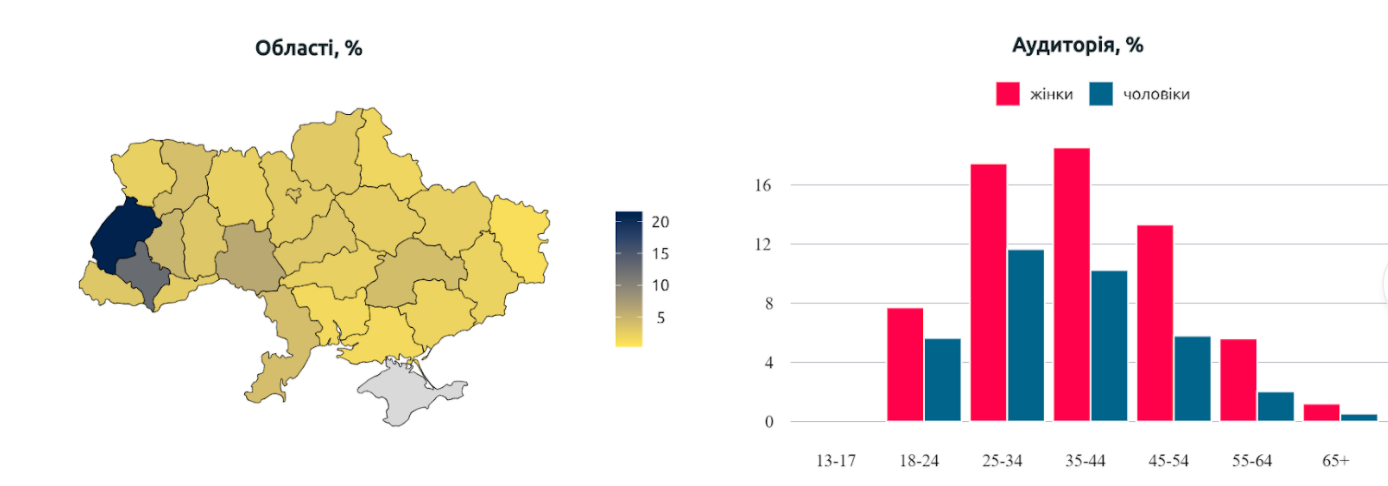
The most active cause promoted by the “Holos” was to advertise the creation of their centers in the regions, to introduce the team, and to invite new members.
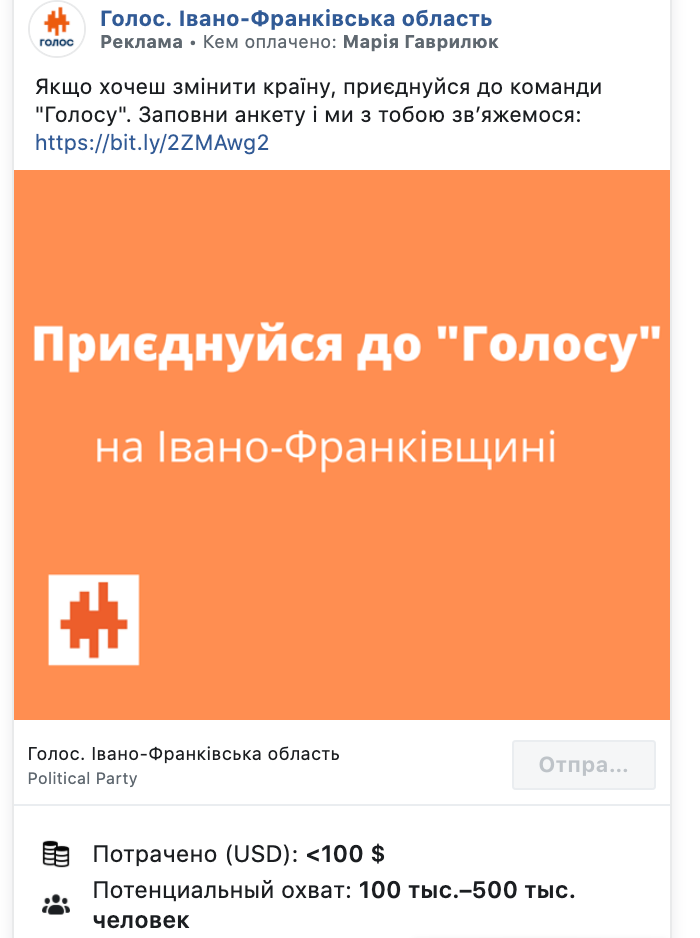
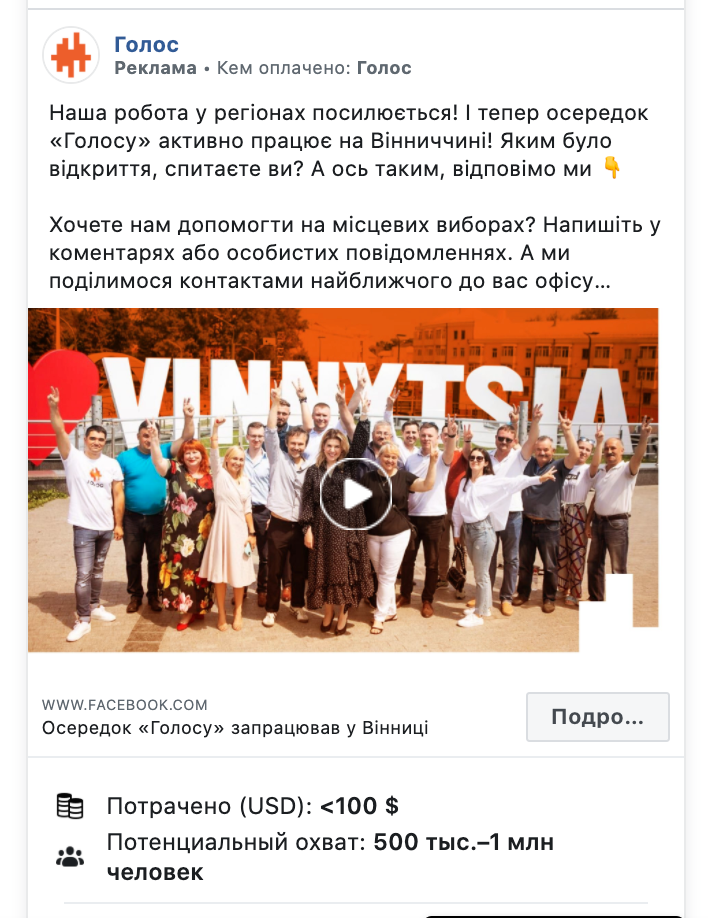
The “Holos” advertising posts describe the leaders of the party’s regional centers, the work of the “Holos” parliamentary faction, etc. The ads also include invitations to the events organized by the “Holos”:
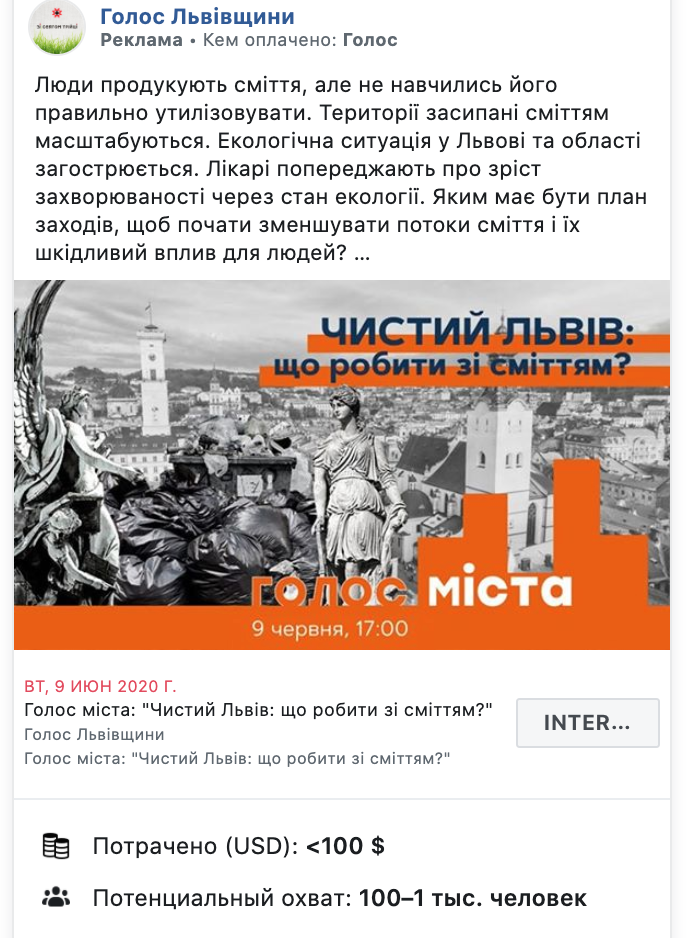
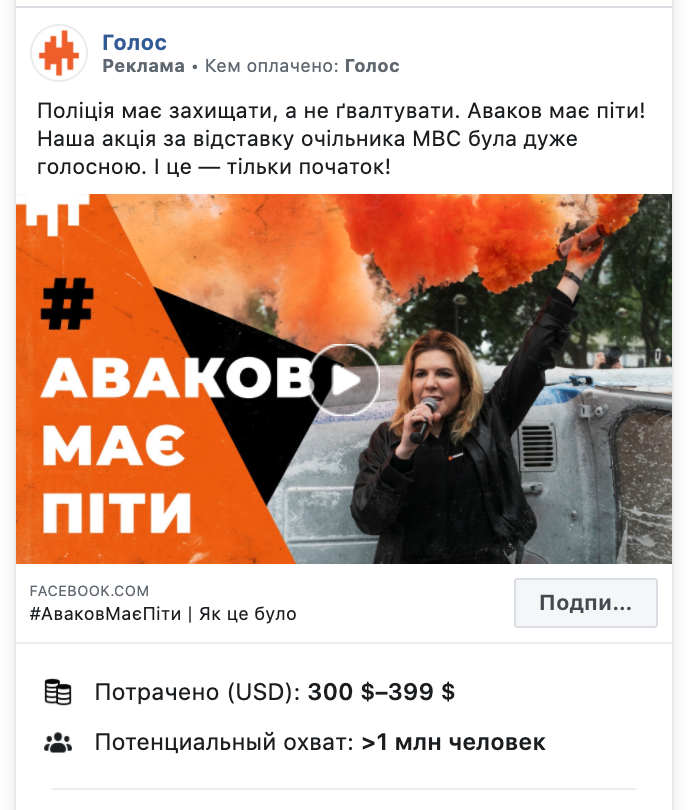
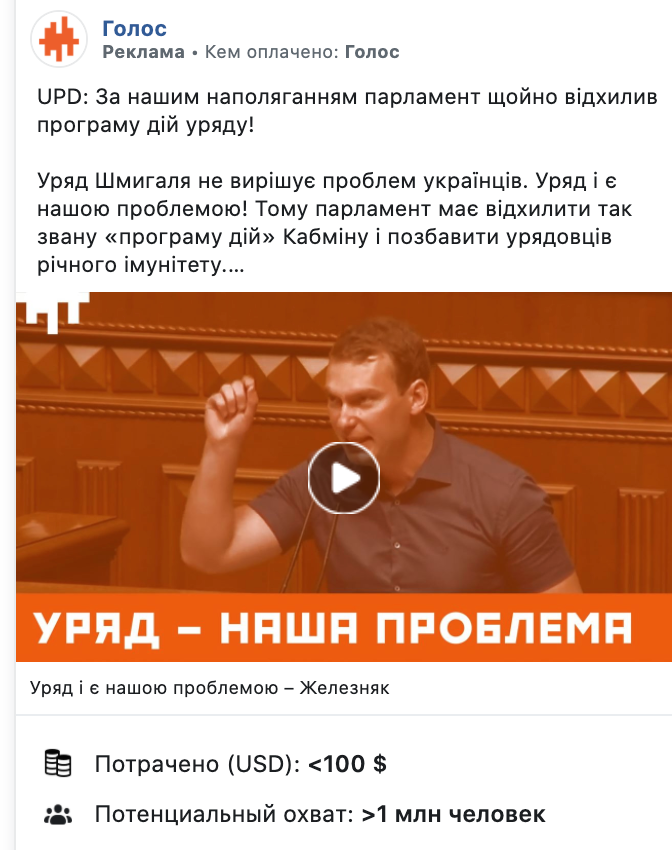
The pages described above are owned by the parties and are clearly associated with them. However, many advertising posts supporting the parties were shared by other pages, too. They could be the pages of the politicians who were the party members, or of the regional centers. In general, the pages spent over USD 65,000 (about UAH 1.8 mln) for political ads.
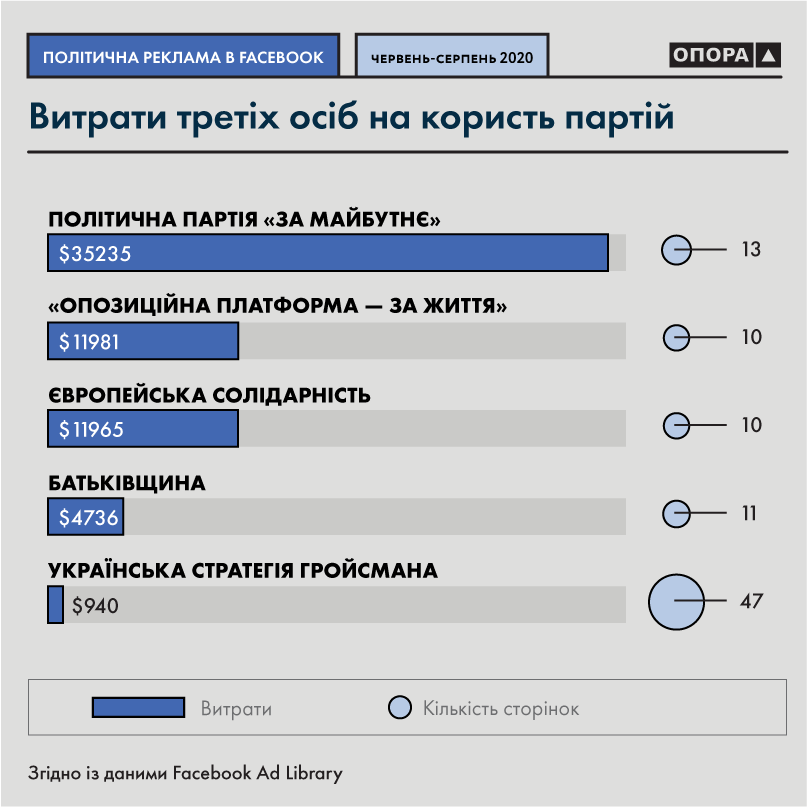
The highest amounts spent for the ads by the “For the Future” party. Of the 13 pages supporting it, 565 ads were shared. In total, it cost over USD 35,000. The posts were published on the pages of the politicians acting as the front men of the party, and they became more active in the middle of August.
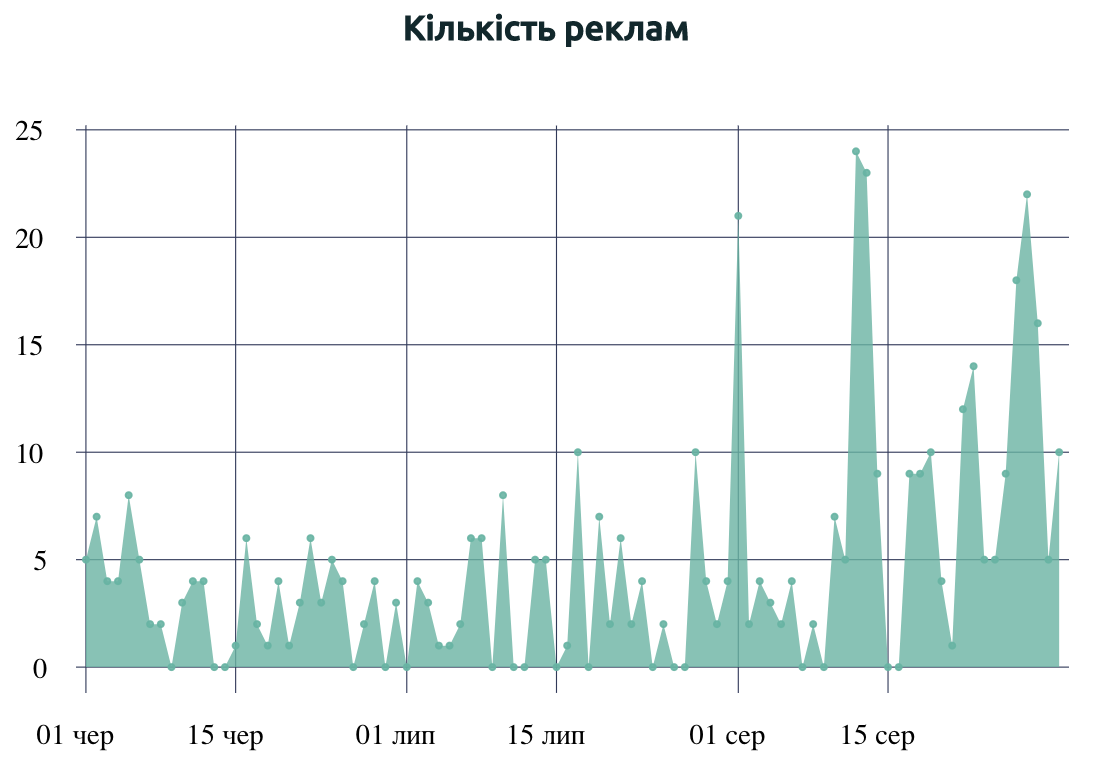
The posts mostly covered the meetings of the party front men with voters and shared key messages “For the Future”:
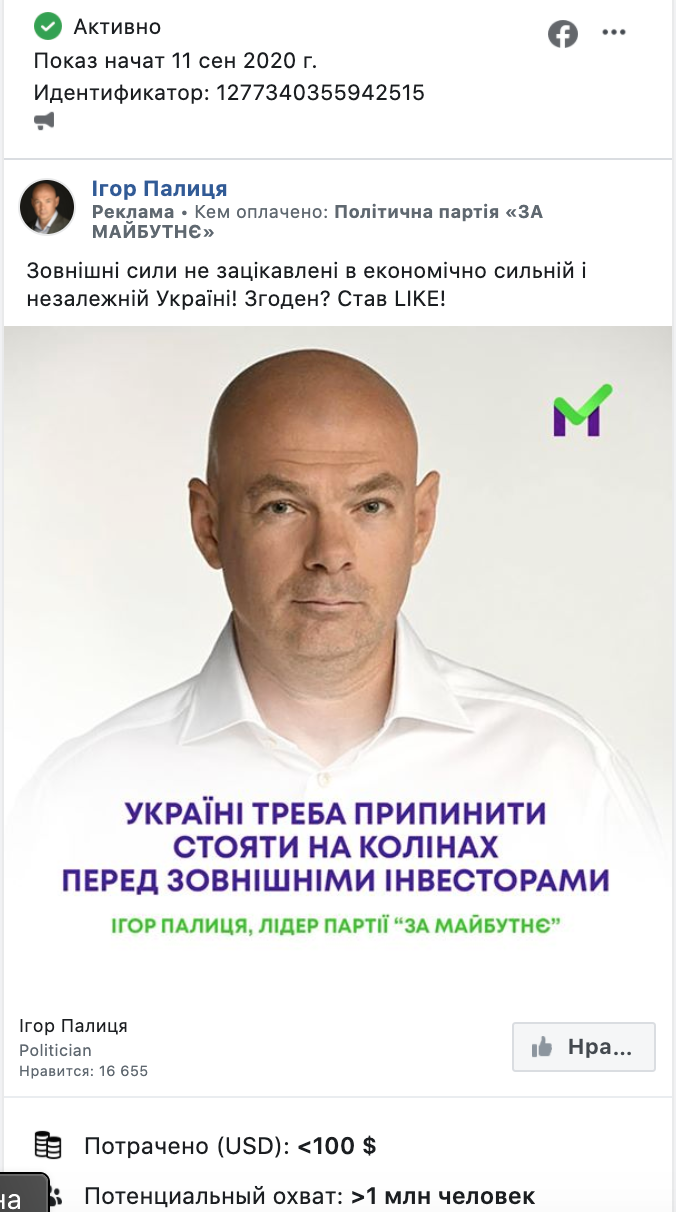
The front men of the “European Solidarity” party posted from their pages 103 ads, with the total cost of almost USD 12,000. Almost all of the amount was spent by the “Petro Poroshenko” page. They mostly write about the party’s position on key issues that have been in focus in the recent years of Poroshenko’s presidency:
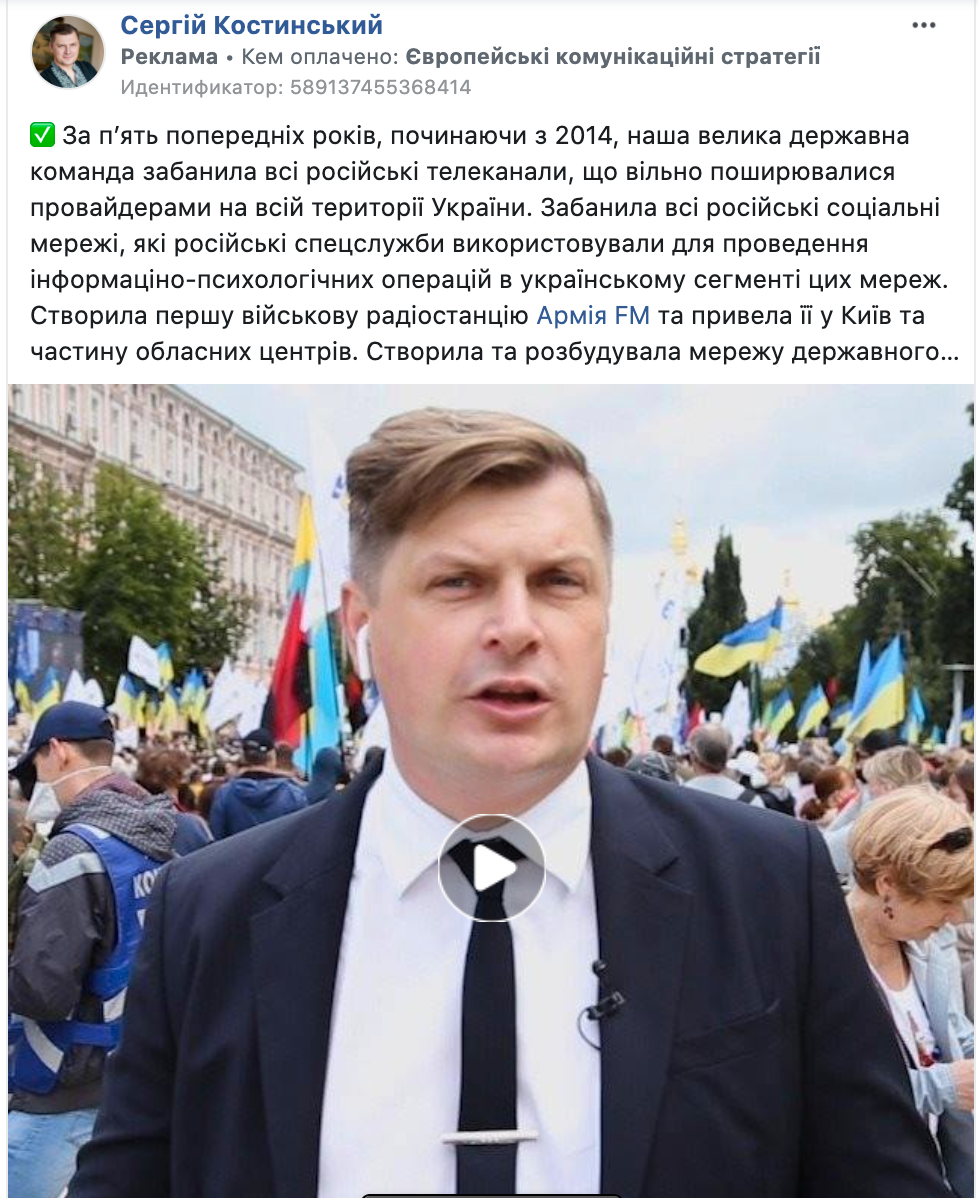

There are frequent posts to support Poroshenko and criticize the “Servant of the People”:
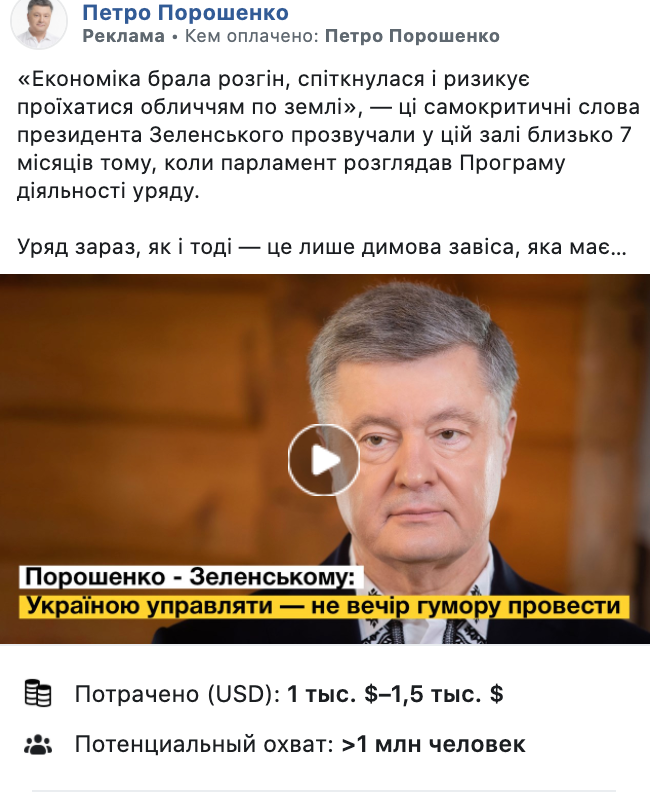
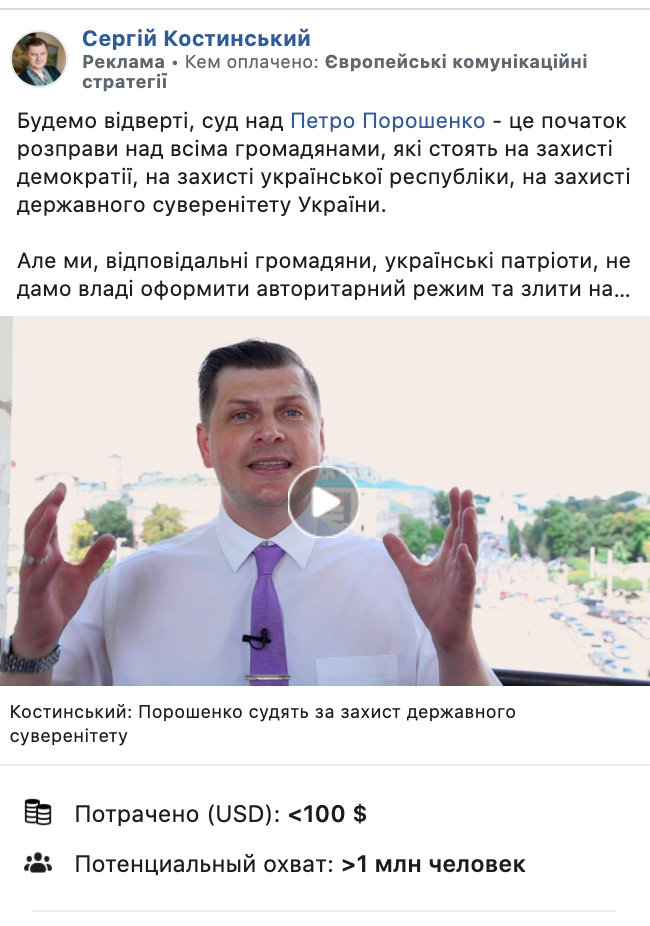
The biggest number of ads on the non-party pages were published to support the “Opposition Platform – For Life”: over 1,400 posts. They were most actively promoted in the middle of August. The OPFL ads were most often (in 43% of cases) targeting Dnipropetrovsk Oblast.
The non-party pages sharing party ads are mostly owned by politicians intending to run at the elections from these parties. The content of posts coincides with the ads on the party pages. However, there were also some exceptions: “Batkivshchyna,” “Servant of the People” and the “Ukrainian Strategy of Groysman” also used the fan pages to share their ads, such as “ Зе”Підтримуємо” [lit. – “We Support Ze”], or the pages of the regional media: “Дніпро News” [lit. – Dnipro News], “Типичный БОРОДОК” [;it. – Typical BORODOK], and the like.
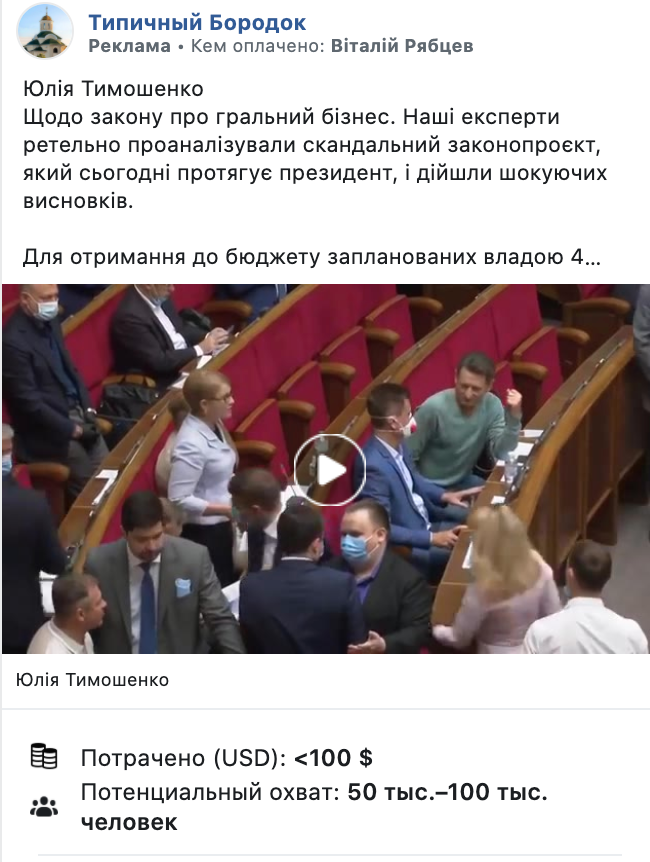
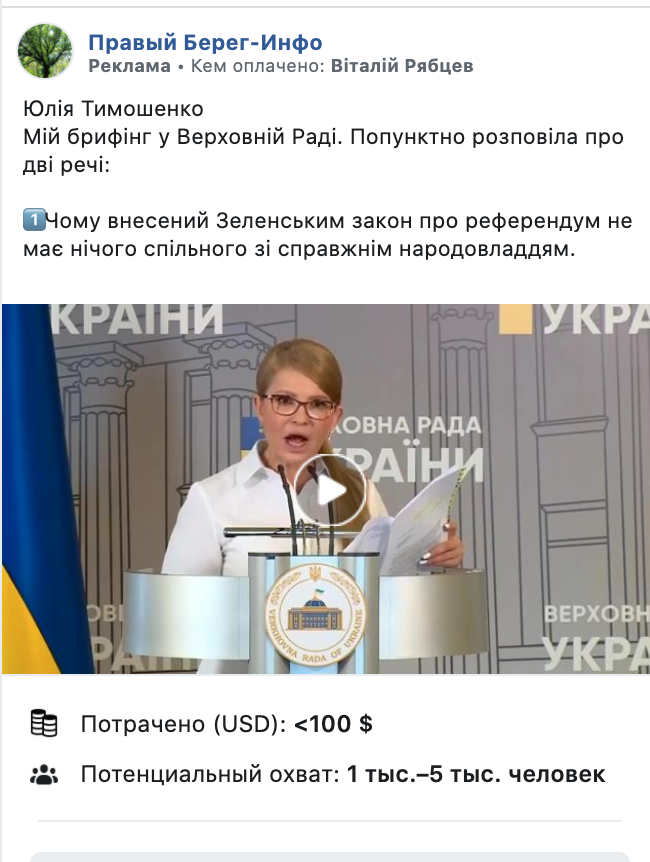
The biggest number of the non-party pages (47) was used for advertising purposes by the “Ukrainian Strategy of Groysman.” The pages posted 173 ads worth USD 940. Almost all of them targeted Vinnytsia oblast, while the target audience included mostly women aged 35 to 64. About half of the pages sharing the Volodymyr Groysman party’s ads in the summer were the local pages of the Visti.Live network: “Ямпільські вісті” [lit. – Yampil News], “Тиврівські вісті” [lit. – Tyvriv News], “Гайсинські вісті” [lit. – Haysyn New], etc. The posts invite to support the party and tell about the work of candidates from the “Ukrainian Strategy” in these places.
Politicians can cheat with campaigning in social media and hide their advertising costs since this area of political ads is hardly regulated at all. Even the recently approved Electoral Code failed to regulate the campaigning on the Internet. The Facebook Political Ads Library that shows the expenditures of political parties for advertising on Facebook and Instagram is one of the few ways to control the political campaigning in social media. Read more about the advertisements of politicians in social media on the OPORA website at the Facebook tag.
